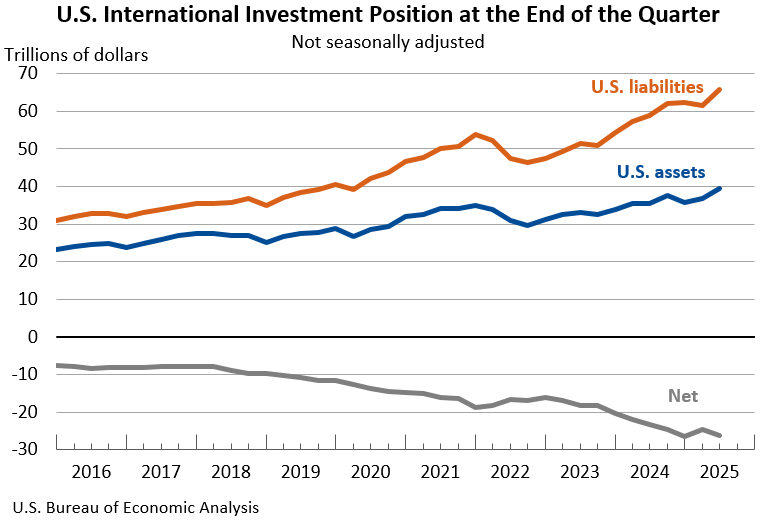Notice
Due to a lapse in appropriations, this website is not being updated.
Bureau of Economic Analysis
U.S. International Investment Position, 2nd Quarter 2025
The U.S. net international investment position, the difference between U.S. residents’ foreign financial assets and liabilities, was -$26.14 trillion at the end of the second quarter of 2025, according to statistics released today by the U.S. Bureau of Economic Analysis. Assets totaled $39.56 trillion, and liabilities were $65.71 trillion. At the end of the first quarter, the net investment position was -$24.65 trillion (revised).
Principal Federal Economic Indicators
Noteworthy
The Latest
Input-Output Accounts: Who Sells What to Whom
At the foundation of BEA's industry statistics are the input-output accounts — a guide to the inner workings of the U.S. economy. These detailed tables can help you trace supply chains, see indirect connections between industries, or study an industry's imports and exports.
2020 Trade Gap is $681.7 Billion
The U.S. international trade deficit increased in 2020 according to the U.S. Bureau of Economic Analysis and the U.S. Census Bureau. The deficit increased from $576.9 billion in 2019 to $681.7 billion in 2020, as exports decreased more than imports. As a percentage of U.S. gross domestic product, the goods and services deficit was 3.3 percent in 2020, up from 2.7 percent in 2019. The goods deficit increased from $864.3 billion in 2019 to $915…
January 2021 Trade Gap is $68.2 Billion
The U.S. monthly international trade deficit increased in January 2021 according to the U.S. Bureau of Economic Analysis and the U.S. Census Bureau. The deficit increased from $67.0 billion in December (revised) to $68.2 billion in January, as imports increased more than exports. The previously published December deficit was $66.6 billion. The goods deficit increased $1.3 billion in January to $85.4 billion. The services surplus increased $0.…
U.S. International Trade in Goods and Services, January 2021
The U.S. monthly international trade deficit increased in January 2021 according to the U.S. Bureau of Economic Analysis and the U.S. Census Bureau. The deficit increased from $67.0 billion in December (revised) to $68.2 billion in January, as imports increased more than exports. The previously published December deficit was $66.6 billion. The goods deficit increased $1.3 billion in January to $85.4 billion. The services surplus increased $0.1…
Personal Income and Outlays, January 2021
Personal income increased 10.0 percent (monthly rate) while consumer spending increased 2.4 percent in January as provisions of the Coronavirus Response and Relief Supplemental Appropriations (CRRSA) Act enacted on December 27, 2020, began to take effect.
Personal Income and Outlays, January 2021
Personal income increased 10.0 percent (monthly rate) while consumer spending increased 2.4 percent in January as provisions of the Coronavirus Response and Relief Supplemental Appropriations (CRRSA) Act enacted on December 27, 2020, began to take effect.
Gross Domestic Product, Fourth Quarter and Year 2020
Real gross domestic product (GDP) increased at an annual rate of 4.1 percent in the fourth quarter of 2020, reflecting both the continued economic recovery from the sharp declines earlier in the year and the ongoing impact of the COVID-19 pandemic, including new restrictions and closures that took effect in some areas of the United States. The increase was 0.1 percentage point higher than the “advance” estimate released in January. In the…
Gross Domestic Product, Fourth Quarter and Year 2020 (Second Estimate)
Real gross domestic product (GDP) increased at an annual rate of 4.1 percent in the fourth quarter of 2020, reflecting both the continued economic recovery from the sharp declines earlier in the year and the ongoing impact of the COVID-19 pandemic, including new restrictions and closures that took effect in some areas of the United States. The increase was 0.1 percentage point higher than the “advance” estimate released in January. In the third…
Gross Domestic Product for Guam, 2019
The estimates of GDP for Guam show that real GDP—GDP adjusted to remove price changes—increased 2.0 percent in 2019. This release also includes the results of a comprehensive update of the territorial economic accounts.
Gross Domestic Product for Guam, 2019
The estimates of GDP for Guam show that real GDP—GDP adjusted to remove price changes—increased 2.0 percent in 2019.




